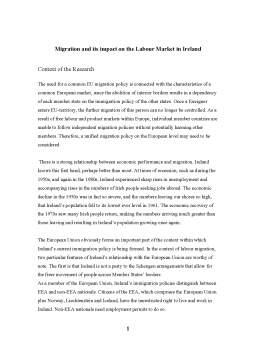Extras din referat
Context of the Research
The need for a common EU migration policy is connected with the characteristics of a common European market, since the abolition of interior borders results in a dependency of each member state on the immigration policy of the other states. Once a foreigner enters EU-territory, the further migration of this person can no longer be controlled. As a result of free labour and product markets within Europe, individual member countries are unable to follow independent migration policies without potentially harming other members. Therefore, a unified migration policy on the European level may need to be considered.
There is a strong relationship between economic performance and migration. Ireland knows this first hand, perhaps better than most. At times of recession, such as during the 1950s, and again in the 1980s, Ireland experienced sharp rises in unemployment and accompanying rises in the numbers of Irish people seeking jobs abroad. The economic decline in the 1950s was in fact so severe, and the numbers leaving our shores so high, that Ireland’s population fell to its lowest ever level in 1961. The economic recovery of the 1970s saw many Irish people return, making the numbers arriving much greater than those leaving and resulting in Ireland’s population growing once again.
The European Union obviously forms an important part of the context within which Ireland’s current immigration policy is being formed. In the context of labour migration, two particular features of Ireland’s relationship with the European Union are worthy of note. The first is that Ireland is not a party to the Schengen arrangements that allow for the freer movement of people across Member States’ borders.
As a member of the European Union, Ireland’s immigration policies distinguish between EEA and non-EEA nationals. Citizens of the EEA, which comprises the European Union plus Norway, Liechtenstein and Iceland, have the unrestricted right to live and work in Ireland. Non-EEA nationals need employment permits to do so.
In January 2005, the European Commission launched its Green Paper on an EU Approach to Managing Economic Migration aimed at beginning a process of debate within the European Union on a common framework of rules across the European Union for admitting economic migrants. In Ireland’s response to the Green Paper, two features of the Irish Government’s strategy on economic migration are clearly spelled out. The first is that the Department of Enterprise, Trade and Employment, which has responsibility for economic migration policy, is actively encouraging employers to recruit low skilled labour from within the European Union. In other words, it is government policy to discourage low skilled workers from outside the EEA from coming to Ireland and that future demand for labour from outside the EEA will be mainly in high skills areas. The second feature is that the present strategy envisages a twin track approach, comprising ‘a permanent migration system with a primary focus of attracting skilled migrants to Ireland which will select people as potential citizens,’ and ‘a fast-track scheme of temporary workers based on sponsorship by employers.’
Asylum Flows and Policies
The number of persons seeking asylum in Ireland increased dramatically from only 362 in 1999 to 11,634 in 2007, before falling again to 7,900 in 2006 . In 2007, the year when applications peaked, the top six stated countries of origin of asylum seekers were Nigeria (34.8 percent), Romania (14.4 percent), Moldova (4.6 percent), Zimbabwe (3.1 percent), Ukraine (3.0 percent), and Poland (2.7 percent).
Asylum seekers do not have the right to take up employment in Ireland. If, however, their applications are successful and they are officially recognized as refugees, they acquire full employment and social rights. Between January 1997 and June 2006, the country officially recognized 6,304 persons as refugees.
Preview document
Conținut arhivă zip
- Migration and its Impact on the Labour Market in Ireland.doc











